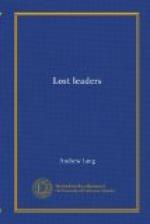Europeans as the capitals of Mars and Sirius.
The wonderful catalogue of which we speak is rich
in relics of this hero. We are offered a chance
to buy his “trunk,” a carved wooden trunk
in which Cortes carried his personal property.
His army chest, which held the sacred gold of Montesuma
and the treasure of the Temple of the Sun, is to be
sold for a consideration. His pistols are also
on sale, and his “field-glass,” which must
be an exceedingly early example of that useful invention.
Whether the field-glass is binocular or not, the
catalogue does not pause to inform us. Corslets
worn by his brave Castilians are also to be vended,
perhaps the very leather and steel that guarded the
honest heart of good Bernal Diaz. But all these
treasures, and even the very “scissors”
of Fernando Cortes, are less enticingly romantic than
the iron head of Alvarado’s spear. Surely
no spear since that of Peleus’ son, not to be
wielded by meaner men, has ever been so well worth
acquiring as the spear of Alvarado, Tonatrish the
sun-god, as he was called by the Mexicans, by reason
of his long, bright, golden hair. This may have
been, probably was, the spear that Alvarado bore when
he charged up the steps of the great Teocalli or God’s
house, rained upon by Aztec darts, driving before
him the hordes of heathendom. With this very
spear, when the summit was gained, he may have fought
in that strange fight, high in air, beheld by all
the people of the city and all the allies of Spain.
Here stood the Christian cross; there was planted
the war-god, Huitzilopochtli; there the two faiths
fought out their battle, and the vanquished were tossed
dying down the sides of the Teocalli. Then the
Spaniard was victorious; fire was set to the Teocalli,
and the cannibal Aztec religion rolled away in the
clouds of smoke and vapour of flame. With the
self-same spear (no doubt) did Alvarado make his famous
leap, using it as a leaping pole to clear the canal
during the retreat of the Night of Dread. Assuredly
Alvarado’s spear, or even the iron head of it
alone, is an object worthy of an archaeologist’s
regard, and scarce less curious than that
“Broomstick o’ the Witch
of Endor,
Weel shod wi’ brass,”
which Burns describes in the collection of Captain Grove. But extraordinary as is the charm of these relics of Anahuac and of Castille, perhaps even more engrossing is the last article in this romantic catalogue, namely, “a green portfolio” giving an account of the various articles, and how they came into the hands of their proprietor. Their pedigree, if authentic, must be most important.




